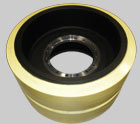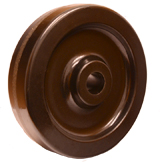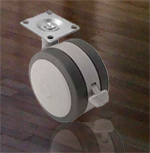A confusing term at times can be bearings in regards to their use in casters. Bearings are used in casters for both wheels and swivel heads, and here we will discuss both.
Wheel Bearings
Wheel bearings sit between the wheel and the axle, and provide a way for the wheel to easily spin on the axle. These bearings come in a number of different types, each with its own advantages.
Delrin bearings are inexpensive, and need no maintenance. They are a simple bushing made of Delrin, a plastic material. Delrin bearings work well in wet applications since they have no moving or metal parts that could corrode.
Roller bearings are best suited to low speed, manual operation with intermittent use. The roller bearing consists of a series of rollers arranged to sit on an axle and easily roll around it. Roller bearings can be solid or split caged. Split cage roller bearings do not handle side thrust as well as their solid counterpart, which is inserted into the wheel with a press. Roller bearings require regular maintenance.
Precision Bearings are a high quality ball bearing. These are excellent for applications that require high speed, quiet, and/or continuous operation. Precision bearings do not require regular maintenance to function properly. Semi-Precision bearings offer a less expensive, low speed and light duty option for those that still want quiet, maintenance free operation.
Tapered bearings are used on the heaviest duty casters. These bearings can handle high speeds and power driven application. Tapered bearings also handle side thrust well, and excel at continuous operation. They do require regular maintenance for good performance.
Please visit our caster wheel bearings page for images and additional information.
Swivel Head Bearings for Casters
Swivel Head bearings are typically ball bearings inside of a raceway. The swivel head assembly and its bearings allow for the wheel to easily turn and add steerability to applications. This raceway can be sealed or exposed. A sealed raceway protects the bearing assembly from dirt and other debris that is harmful to the bearing. The raceway can also be precision made and hardened to increase the longevity and performance of the swivel head.



 Like any person dealing with rehab, he has good days and those that are not as good. The hope is that the tortoise will regain a normal walking rhythm and subsequently a normal tortoise life. The Service Caster family shares that hope and wishes Reaper the best while recovering.
Like any person dealing with rehab, he has good days and those that are not as good. The hope is that the tortoise will regain a normal walking rhythm and subsequently a normal tortoise life. The Service Caster family shares that hope and wishes Reaper the best while recovering.